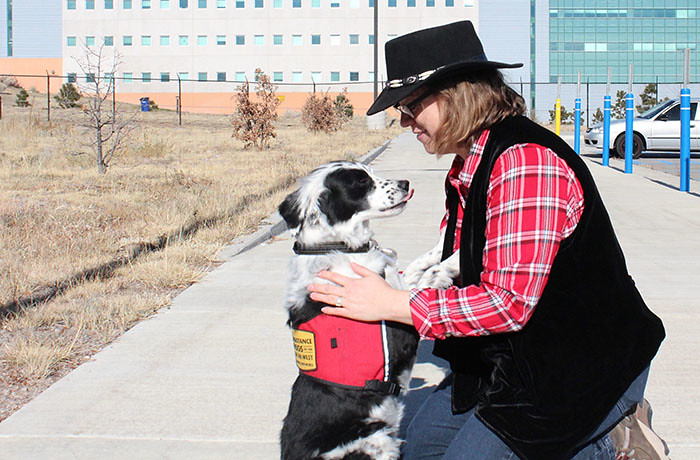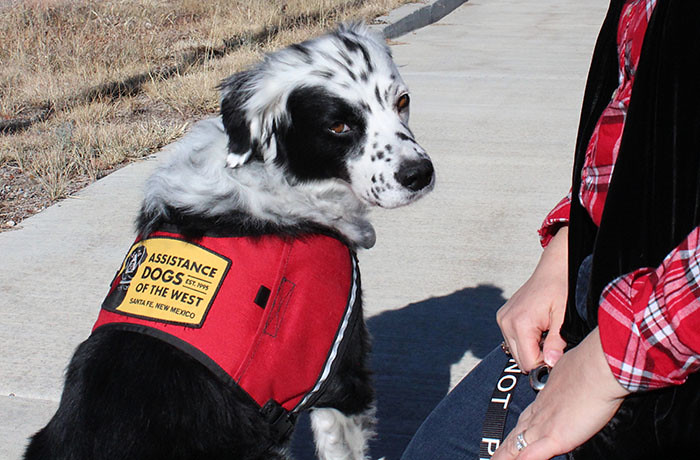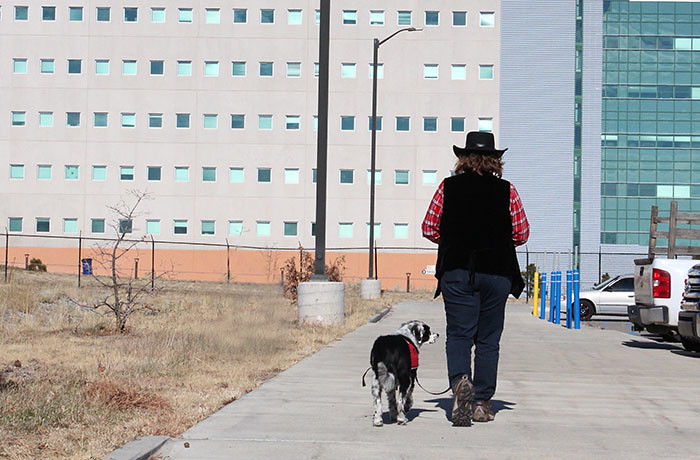Rescue mutt becomes Lab’s first assistance dog

When Steinfadt is consumed with pain, Houdini is a lifesaver, she says. “Sometimes the pain is your whole world and you’re just trying to survive. But the medical alert dogs, they’re like little rock stars. He helps me deal without words.”
A hairy yet impeccably well-groomed fellow shows up for work every day at Los Alamos National Laboratory. But despite his professional demeanor and commendable work ethic, this small chap with kind eyes and a big heart is not eligible for a security clearance: his checkered past is questionable at best.
And he’s a dog.
Houdini, the Laboratory’s first assistance dog, belongs to computer scientist Shane Steinfadt. But before he began his career as Steinfadt’s trained medical alert dog, Houdini was an escape artist.
By the age of three, Houdini had escaped from his various adoptive homes and the Los Alamos County Animal Shelter more than nine times. “Houdini has severe separation anxiety and becomes destructive when he’s left alone,” Steinfadt explains. “He’d eaten through a plastic crate and freed himself and several other dogs from the shelter a couple of times before we adopted him.”

Since finding his forever home with Steinfadt, Houdini’s anxiety has abated and he’s become a certified assistance dog, the first to grace the Lab’s grounds in its 72-year history.
Houdini goes pro
In 2010, Steinfadt’s foot was crushed during an office move, and since then she’s suffered from extreme pain. She’s used a wheelchair, a knee scooter, and a cane to get around, and after adopting Houdini as an unskilled rescue pup, she found that his natural tendency toward medical alert was a huge help with her medical issues.
“Houdini started giving me indicators I was having a problem before he ever had any training,” Steinfadt says. If Steinfadt is feeling unwell, Houdini seems to realize it, and he’ll nudge her with his nose or whimper. His behavior helps Steinfadt recognize when she needs to stop and assess. “One time I had an antibiotic pill in my pocket that I planned to take at 7 p.m. and at 7:10 p.m., he nudged on my pocket where the pill was, reminding me to take it. He’s helped me get through a lot of pain. He’s a wonder dog”
The talented black-and-white collie mix does a kind of pressure therapy with Steinfadt when he senses or smells her distress. “He’ll get on my lap on a chair or on the floor, or press his head or paws on me,” she says. “It’s been so life changing.”
Houdini and Steinfadt learned these techniques from Assistance Dogs of the West (ADW), a program in Santa Fe that serves individuals with disabilities and groups that use dogs to foster a calming environment.
Houdini was four-and-a-half years old when Steinfadt applied for his training, which one teacher compared to “starting work for the first time when you’re 50.” Fewer than one percent of owners’ dogs pass the stringent requirements and training to become assistance dogs, and typically, Labrador puppies fit the profile best. But Houdini is no typical border collie/springer spaniel mutt.
He’d already shown he had the brains and the temperament to be an assistance dog, but at ADW Houdini became desensitized to noise, crowds, and youngsters through repetition and using rewards. Houdini learned to perform complex tasks despite distractions.
Before he started his training, though, Steinfadt already had been taking Houdini with her everywhere she went as a solution to his separation anxiety. He had also excelled in a doggie dance class at PetSmart that teaches owners and pups dance moves like the conga and spins, proving to his owner that he liked training and working.
With ADW, Steinfadt and Houdini continued the public access training. “We took him to restaurants, to DeVargas Mall, and to Smith’s,” she says. “We structured our lives around the dog, and it paid off for both Houdini and me.”
Steinfadt was also taught to read the environment and human and dog behavior. When the activity around Houdini overwhelms him, he tucks his tail, flattens his ears, or otherwise shrinks into himself, in which case Steinfadt knows to remove or distract him from the environment. “I learned to watch his body language and recognize when he was doing OK, too. ADW training advocates for the dog as well as the owner,” Steinfadt adds.
Becoming a Lab dog
At the Lab, the Americans with Disabilities Act (ADA) point of contact helped Steinfadt take the steps to get Houdini approved in the workplace after he earned his certification and donned his red vest. “The Laboratory is dedicated to creating an inclusive work environment, including for individuals with disabilities,” says Susan Harris, Human Resources Division Leader. “We have and will continue to provide reasonable accommodations to both applicants and employees to assist them with either applying for a job or performing the essential functions of their position. Shane and Houdini are an excellent example of these kinds of efforts. We’re proud of them both and are grateful for the successes they’ve been able to achieve together.”
In addition to advocating for continued ADA efforts, the biggest way Laboratory employees can support Steinfadt and Houdini is simple: pretend Houdini doesn’t exist. “The assistance dogs are the elite, and they get access (to places other dogs don’t,) but they’re working and shouldn’t respond to people. Be respectful to the owner/handler and don’t expect them to engage,” she says. Houdini does get playtime at the dog park nearly every day where he sheds his professional red vest and romps off his herding dog energy.

Lab employees looking to help dogs like Houdini find forever homes can give to the Los Alamos County Animal Shelter through the annual employee giving campaign.






